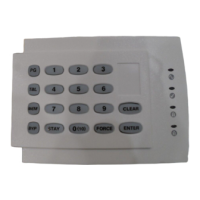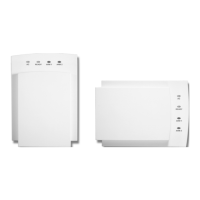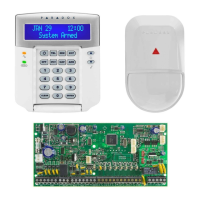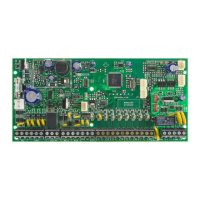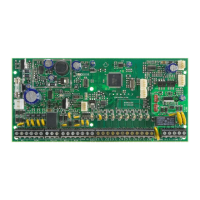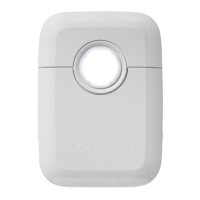
Do you have a question about the Paradox SPECTRA SP65 and is the answer not in the manual?
| Partitions | 2 |
|---|---|
| Keypads | Up to 8 |
| StayD Mode | Yes |
| Users | 32 |
| Event Buffer | 256 events |
| Battery Backup | 7Ah |
| Zones | 32 |
| PGMs | 4 |
| Communication | GSM |
| Power Supply | 16.5 VAC |
| Outputs | 4 |
Defines the system master code and its capabilities.
Explains the roles and limitations of Master Codes 1 and 2.
Describes the duress code for silent alerts.
Details the options for user code length and security.
Step-by-step guide on how to add or modify user codes.
Step-by-step guide on how to delete existing user codes.
Instructions for enabling chime zones on different keypad types.
Instructions for disabling chime zones.
Explains how to view trouble conditions and lists key/LED indicators.
Describes the beep tones used for confirmation and rejection.
Explains the meaning of keypad lights and status indicators.
Instructions on how to enable or disable keypad muting.
Guide to adjusting keypad backlight brightness and auto-dim settings.
Details the power save mode function for the K37 keypad.
Details the function of keys and indicators on the K636 keypad.
Details the function of keys and indicators on the K10LEDV/H keypad.
Explains icons and their meanings for K35 and K37 keypads.
Details the function of keys and indicators on K32LCD+ and K32LX keypads.
Describes visual and auditory feedback for REM2/REM25 remote controls.
Instructions for enabling and disabling StayD mode.
How to change between Stay, Sleep, and Full arming modes.
Procedure to transition from Stay mode to Full arming when leaving.
Procedure to transition from Full arming to Stay mode when entering.
How to leave the site without altering the current arming mode.
Covers Window Mode and Live View Mode features.
How to arm the system in regular mode.
How to arm the system in sleep mode for enhanced security.
How to arm the system in stay mode for perimeter protection.
How to temporarily disable specific zones.
Step-by-step instructions for bypassing zones.
How to arm the system without a user code.
One-touch method for regular arming.
One-touch method for stay arming.
One-touch method for sleep arming.
One-touch method for bypass programming.
How to exit with the system still armed.
How to program automatic arming at set times.
How alarm events are shown on the keypad.
Steps to disarm the system and deactivate an ongoing alarm.
How to activate panic alarms (police, medical, fire).
How fire alarms are reported and handled, including delayed zones.
Setup for receiving event notifications via SMS.
Step-by-step guide to configure GSM module for SMS alerts.
Defines which events trigger SMS messages.
Examples of alarm, arm/disarm, and trouble SMS messages.
Format for the user code in SMS commands.
Format for arm/disarm actions in SMS commands.
Format for specifying partitions in SMS commands.
Format for specifying the notification phone number in SMS commands.
How to get the GSM module's IP address via SMS.
Field to enter the GSM module's phone number.
How to use the VDMP3 Voice Dialer for system control.
Step-by-step guide to calling and interacting with the VDMP3.
Diagram illustrating how to make calls to the VDMP3.
Diagram illustrating how to handle incoming calls from the VDMP3.
How to use PGMs for system automation and control.
How to divide the system into two distinct partitions.
Describes specific key combinations for system functions.
Notes on system partitioning and zone assignments.
Options for one-touch arming and bypass.
Configuration for panic alarm types and reporting.
List of available Programmable Outputs (PGMs).
Key combinations for PGM functions and smoke reset.
Settings for exit and entry delays.
Field to enter the GSM module's phone number.
Fields for installer, servicing, monitoring, and connection details.
Overview of quick programming menus for user, delays, and time/date.
Steps for programming user codes and assigning remotes.
Steps for setting entry and exit delay timers.
Steps for setting the system's time and date.
Steps for initiating communication with BabyWare/GSM.
Options for siren squawk and exit delay with remotes.
Steps to assign a REM3 remote to a user.
Steps for entering the user code for remote assignment.
Steps for confirming the user code.
Steps to learn the remote keypad.
Steps to assign the user to partitions.
Steps to send a test report to the monitoring station.
Steps to program auto-arming for partitions and modes.
Steps to erase lost remote controls.
